How To Design App To Collect Data Using Access
Whether you need to manage customer data, organize inventory information, or keep track of your business contacts, there's likely an app for that. Or 30. The only problem is, no app is a perfect match to the way you work.
In your business, you have specific customer characteristics to track, unique inventory to categorize, or new types of contacts to file away. So with custom needs piling up—and software options whittling down—you come to a conclusion: it's time to build your own web app. But the thought of that—the billable hours or staff time—make you cringe.
Fortunately for you, there's another option you may not know about: building your own internal tool with a database builder.
From tools like Microsoft Access to more modern apps like Zoho Creator, there are database builders that make it simple to build any type of app you need. The only requirements are that your data can be entered with a form, stored in a database, and displayed in common rows, tables, or charts. If you're able to manage that, you'll get an app with just the features you need, and it won't even be that difficult to make it or break your budget.
Learn About Database Builders
- Why Build Your Own Tools?
- The Database Builder Solution
- An Intro to Databases and Common Terms
Build Your Own Internal Tool
- Lay the Foundation
- Pick a Database Builder
- Put Your New Internal Tool to Work
The Need for Custom Internal Tools
"Although I have never written a line of code in my life I was able, with the video tutorials, to build a decent database and interfaces."
Have you ever needed a particular tool for your work, but even after trying dozens of apps couldn't find anything that fit your needs precisely? That was exactly the dilemma the inVigor Law Group had in finding a tool to track their work for billing and more.
"We'd tried a number of different solutions and they were all clunky and not customizable," says inVigor Law Group founding partner Kyle Hulten. Even the industry-leading time-tracking app for lawyers, Clio, didn't fit their needs.
"Clio just wasn't customizable enough," said inVigor Law Group founding partner Kyle Hulten. "We have a largely transactional practice (meaning we do more contracts than litigation) and Clio and most legal productivity software is built for litigation. We'd tried a number of different solutions and they were all clunky and not customizable."
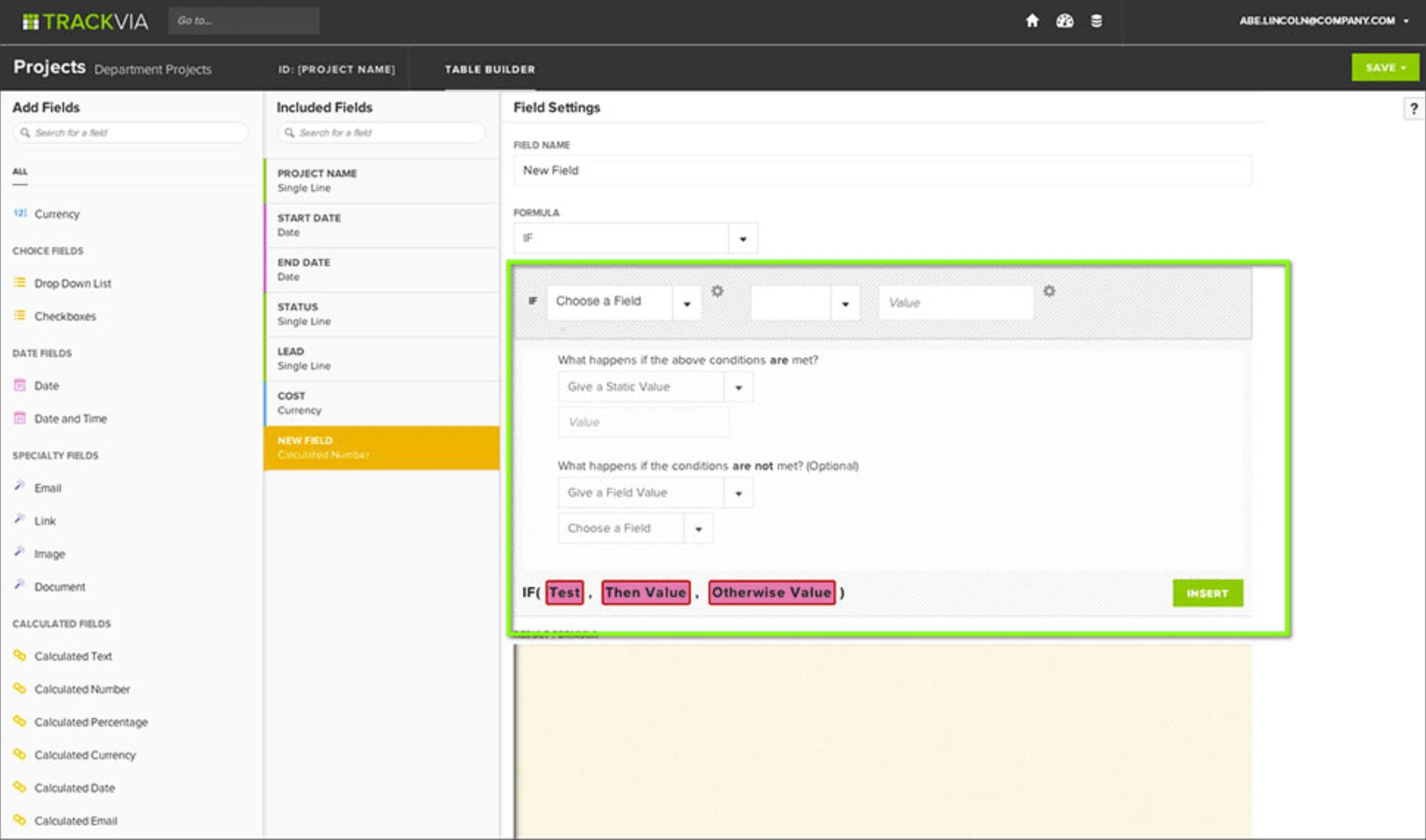
Using TrackVia to build a customized tool
TrackVia, a database builder that makes it easy to create your own internal tools, saved the day. The inVigor team used TrackVia's tools to build forms they'd need to collect data, charts and tables that'd display their data, and used Zapier—and app integration tool—to connect to their other software. And before long, they had their own database-powered internal tool that did everything they needed.
Coding your own custom software is difficult, time consuming, and expensive—it's far more trouble than most teams can justify. But with a database builder like TrackVia, Knack, or even Microsoft Access, you can make something that works like that app you've always wanted for your business without touching a line of code.
The Database Builder Solution
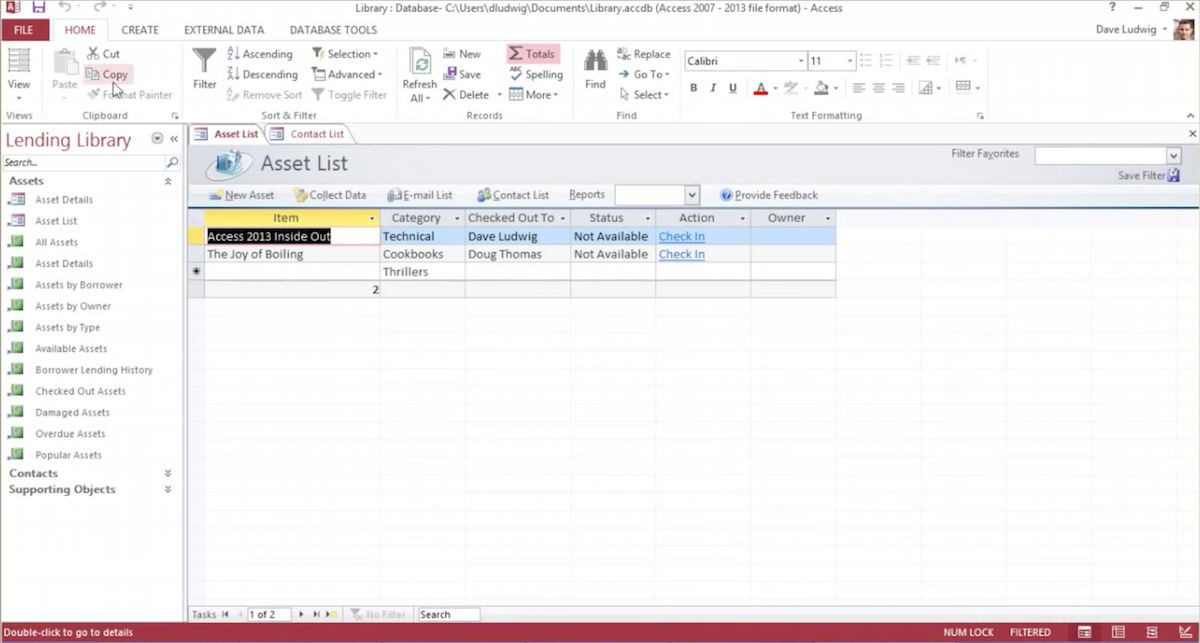
Microsoft Access has long been the first choice for companies who want to build their own internal app
Start listing the apps you currently use or need for your business—the tools that track your customers, inventory, and finances—and you'll quickly realize that most of them, at their core, are built to store data. Each one has an interface that makes it easy to add, view, and manage that data, but they're all built on a database that keeps things organized.
That's the basic framework for most apps: a main interface that you interact with, and the hidden code where your app data is stored. Your CRM, inventory manager, and even social network apps are all—on a basic level—a database with a pretty face.
If you ever tried to make your own app on a PC in the '90s or early 2000s—or if you worked at a small store that had their own custom in-house programs—there's a good chance you used Microsoft Access. That's the database program that was bundled with professional versions of Microsoft's then-ubiquitous Office suite, and it promised the ease of Excel with the power of a database-builder. (Let's not dwell on whether or not Access lived up to that promise).
Today—through newer versions of Access and other online database builders like Knack and Zoho Creator—it's even simpler to make your own software tools.
What is a Database?
When I imagine a database, I picture a giant, searchable server farm that stores billions of data points—the kind of thing that the cast of CSI would tap to cross-check a fingerprint fragment against thousands of criminal profiles. Like most Hollywood depictions, that's a little overblown, but it's not totally off base.
A database ("DB" for short) is a structured collection of data. The key word there is "structured": searching an unstructured database would be like trying to thread a needle in a dark cave with oven mitts on.
In most database systems, each piece of data—everything you save into the database—is related to other pieces of data. A contact, for instance, may be related to all other contacts from the same company, or all others that live in the same state, or all others that have shown interest in the same product you sell. And a good database will make it easy to surface those related pieces of data.
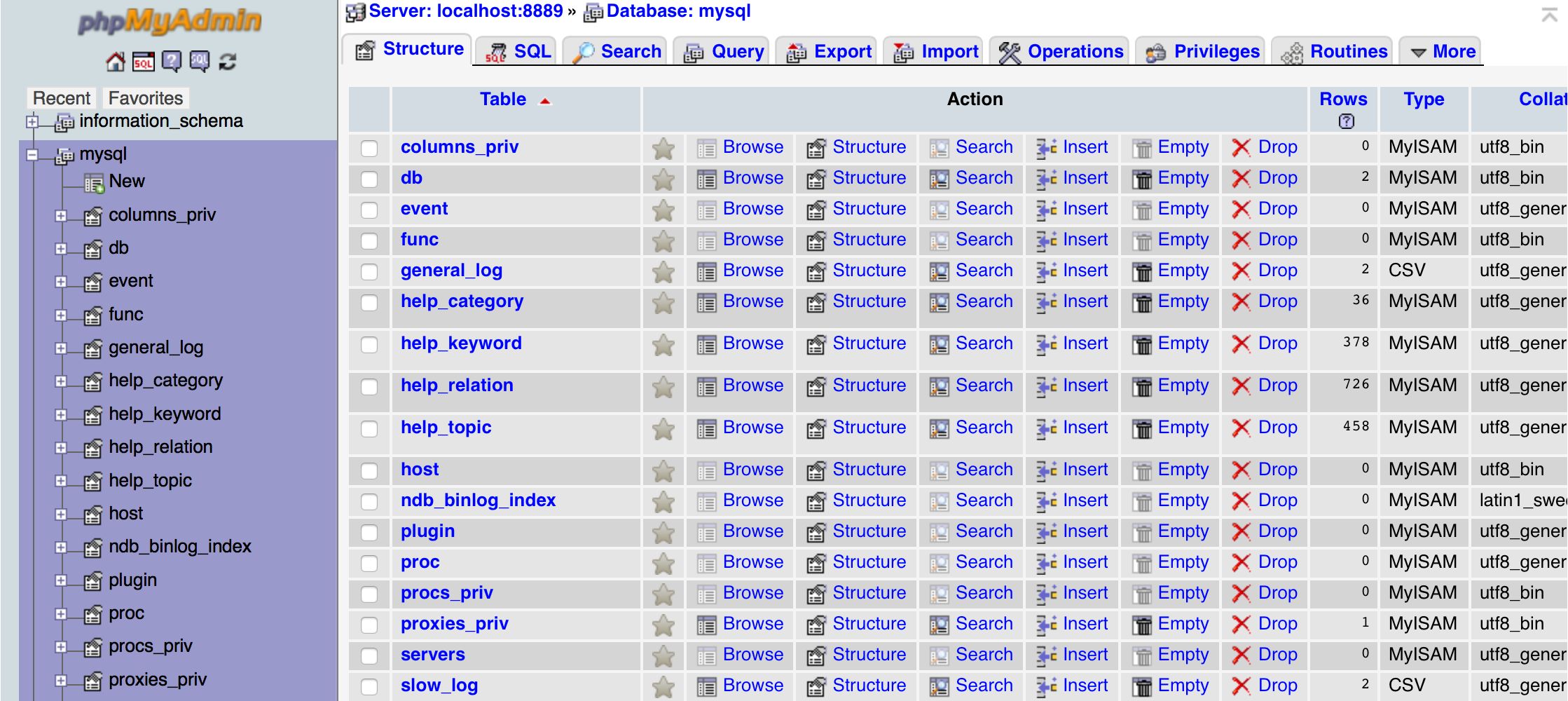
The Admin screen for a MySQL database
Of course, databases aren't the only way to store your data. For things like personal finances of a list of contacts, a spreadsheet should do the trick. Even a plain text or Word document could work (if you enjoy tormenting yourself).
So why a use database? Because you need to do more with your data than just see it in a list.
In a spreadsheet, you could sort your addresses by state, or your contacts by company—or perhaps you could use your app's search tool to dig a bit deeper. In a database, though, you'll be able to make queries that show those specific, related pieces of data. And, unlike the data that compiles inside your form app, you'll be able to update the data that's been entered over time, and reuse existing data in new forms.
It's that ability to update data that led the Lotus Gardens team to use TrackVia, a simple online database tool, after having trouble manually updating spreadsheet info with new data from Wufoo form submissions. "We were finding the information increasingly tedious and complicated to manage details such as personal info, membership discount, housing, meals, our shuttle service, etc." says Lotus Gardens' Linda Fisher.
Switching to TrackVia and using its integration with Zapier—an app connecting TrackVia to hundreds of complementary apps—to keep things up-to-date simplified their work immensely. "The relief was amazing—seeing things move from Wufoo to Trackvia in real time!" Fisher says.
Before you dive into making your own internal tools with a database builder, though, here's a quick primer on the terms you'll need to know as we dissect the available options for simple online databases.
Common Database Terms
- Database: A file that contains your entered data in a structured, organized format that enables easy access to data.
- Database Builder: An app that makes it easy to create a database, along with the forms and tables needed to add and view data in the database
- Table: A set of related data inside a database, similar to a sheet in a spreadsheet.
- Field: A set of data inside a database table that describes one aspect of the data entry, similar to columns in a spreadsheet where each data item is a row in the spreadsheet.
- Record: One data item, which is stored in a database table and is made of of entries in any number of fields.
- Query: A search or filter that displays a set of your data records.
- DBMS: An acronym for Database Management System, or in other words an app that manages a database.
- SQL: A popular programming language to manage data in a database, used in MySQL, Microsoft SQL Server, and more.
There are other database terms, including those for their related apps and tools, but these are the ones you need to know to use the following database builders in this chapter, and then some. If you really want to learn more about databases, the Wikipedia article on databases is a good place to start.
For now, let's look at how you can build a simple database-powered internal tool.
1. Lay the Foundation
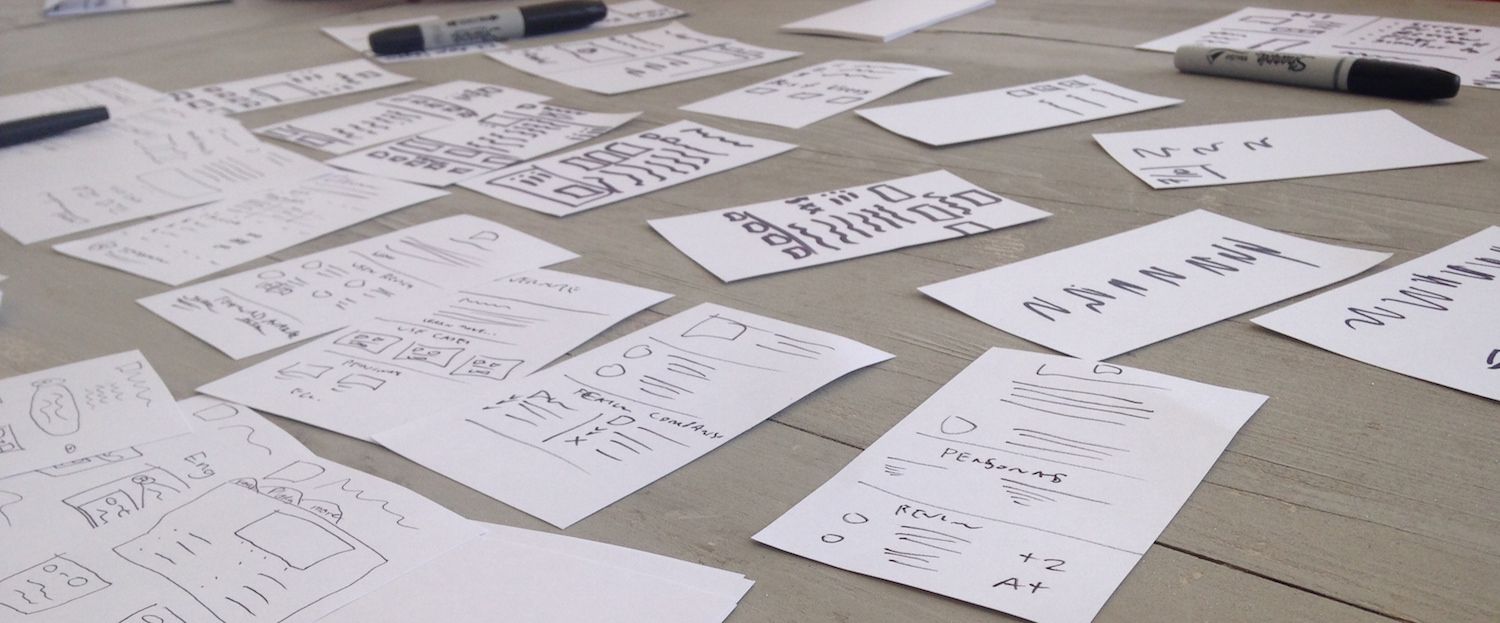
Sketches of Zapier's review pages, made during our design process
You likely already have some idea of what you want your own internal tool to include—the things your team will need to track, the reports in which you'll need to find those things again easily, and more. You've likely used or seen apps similar to what you want, and have a list in the back of your head of aspects that you'd like to be different, just like the inVigor Law Group did.
Before you dive into one of the app builders below, however, you should stop and list your team's requirements from the internal tool you need. Start asking broad questions. What data do you need to collect? How do the piece of data relate to each other—do you need to sort products by category or contacts by company or industry, for instance? If so, those will make up the "tables" and "fields" in your database, and you'll need form fields to make it easy to add each of them.
Then ask the team: What do you want to do with the data? List each answer and keep that document handy as you'll want to check over it when evaluating the database builders below. These answers will become the "views" and "pages" in your internal tool.
Once you've planned what you'll need from your tool, you'll be ready to actually start building it while you're trying out apps below.
2. Pick a Database Builder
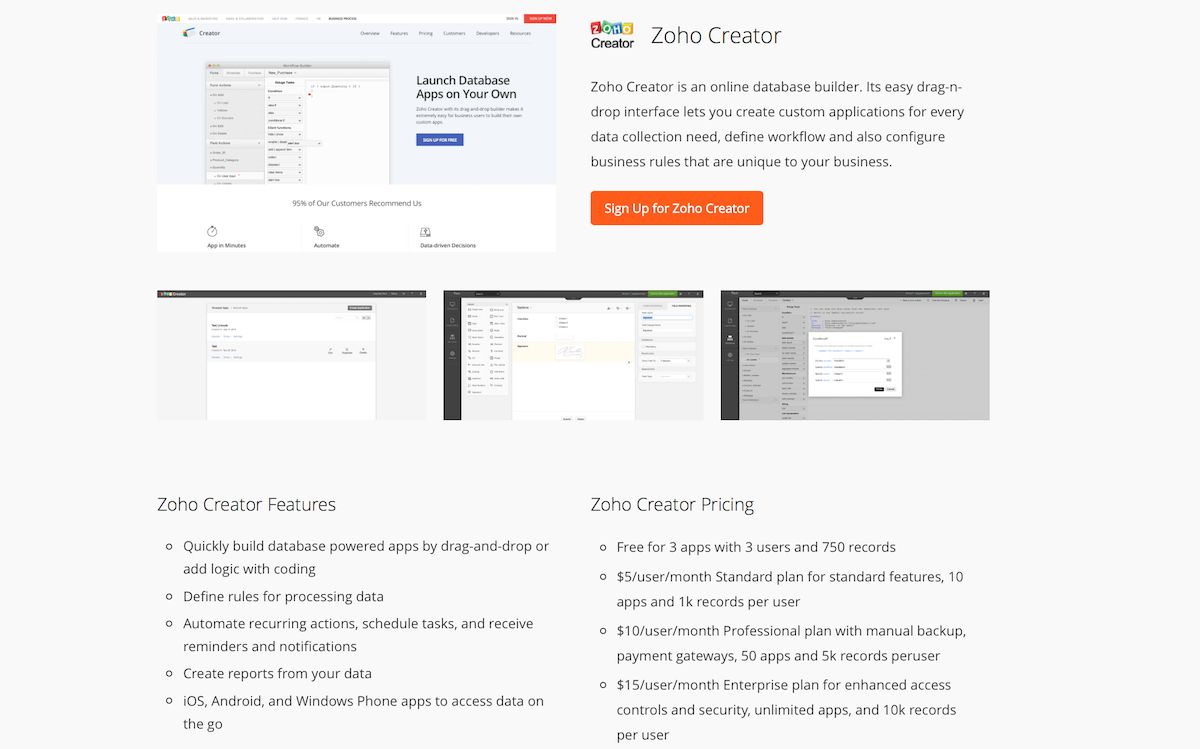
Now that you're ready to build your own database-powered tool, here are the best database builders we've found for the job. Each one makes it easy to make forms, collect data, and sort through that data. Plus, they each have their own features to make them unique.
Each database builder's name and screenshot is linked to a full review of the app, so be sure to click through to the review to learn more about the details that might sway you towards one app or another. You'll also find extra screenshots, features, companion apps, and detailed pricing info in each review.
TrackVia
for building quick, graphical apps

If your business has already been collecting data for some time, you've likely been using spreadsheets as a manual database. There's no need to reproduce your work, though, since TrackVia can turn that spreadsheet into a database-powered app for you. Just upload your spreadsheet, and it'll turn sheets into tables and columns into elements, and import the data automatically.
Better yet, get started quickly by using one of TrackVia's pre-made apps. You can import inventory tracking, project management, CRM, and other app templates, and customize them as you want. And if you want to make your app a bit smarter, you can add formulas and logic flows from simple drop-down menus that let you code without typing in any text.
Then, when you're working on the go, TrackVia has you covered, as well. Most web apps will work OK from your smartphone and better on your tablet, but they're not not ideal and you'll often find yourself constantly zooming and trying to tap the right button. That won't be a worry with TrackVia, since it includes iOS and Android apps that let you add data, view and sort through it, and more all from your phone. It won't be exactly like your full-featured internal tool, but you'll get most of the features from wherever you are.
- Price: Custom pricing available upon request
- Skill Level: Beginner—very easy to use, with templates and spreadsheet imports
For a deeper look at features and pricing, see our TrackVia review .
Knack
for simple database building
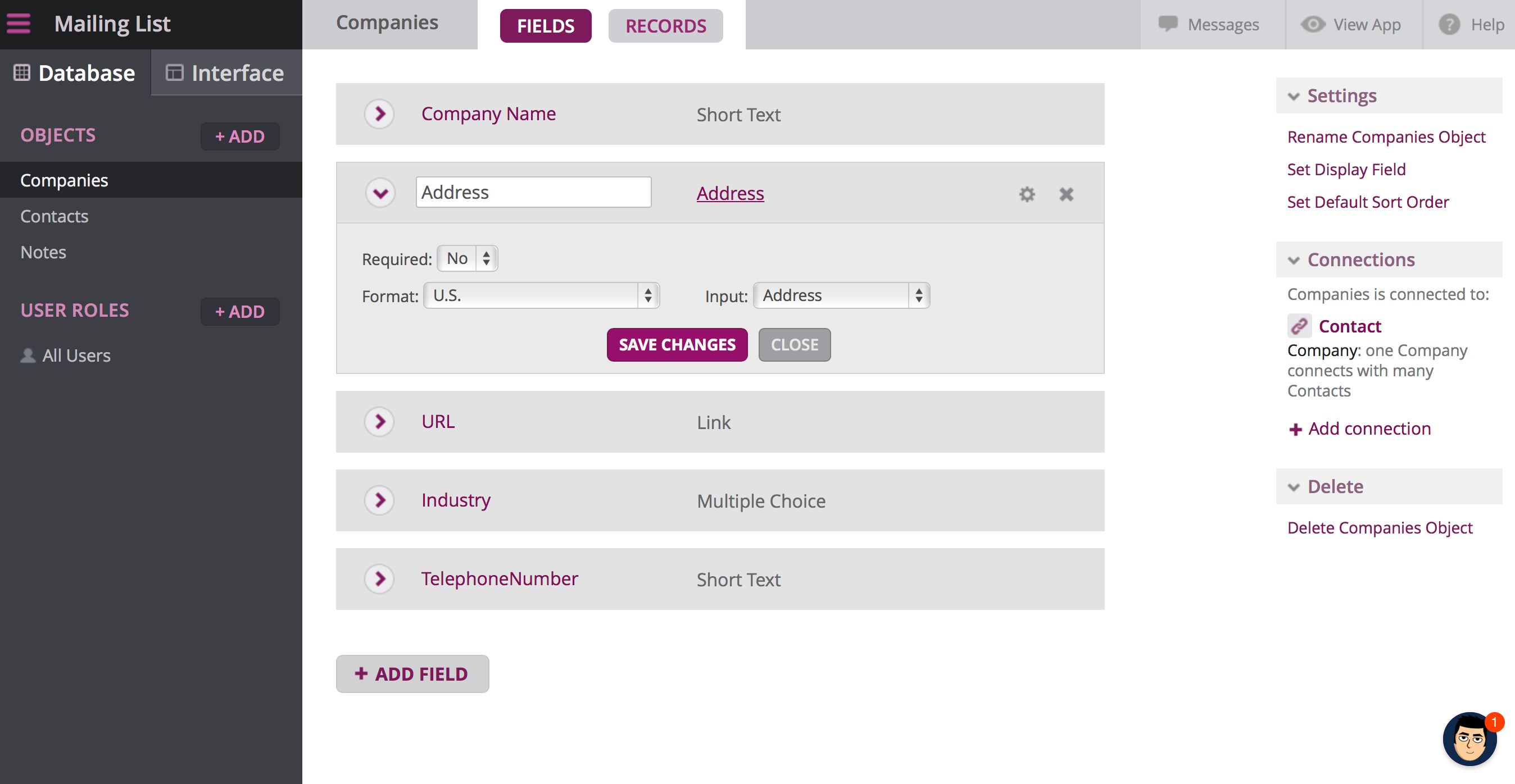
Knack is another simple take on a database builder, one that's focused a bit more on your database itself. When you first open Knack, you'll be asked to add the database objects (or tables) where you'll store the data, and the fields that each table needs along with the type of data the field is for. That'll help you make sure you are collecting all the data you want and storing it in an orderly manner.
Then, Knack does the rest of the work for you. Click the form button to add a form, for instance, and Knack will ask you to select a database object and then will automatically create a form that includes all of the fields you already added. It'll do the same with views, giving you simple ways to sort through and visualize your data based on the work you already put into your database.
If you want to add more features to your internal tool, Knack includes Workflows that'll automatically run whenever data is added. You can use them to sort data, verify it, send notifications about new entries, and more. Then, if you're using your app to collect data for your website, you can embed your Knack views into your site to share your work with the world.
- Price: $39/month Starter plan for 3 apps and up to 20k records
- Skill Level: Beginner—quite easy to use, though you will need to think more about your database
For a deeper look at features and pricing, see our Knack review .
Zengine
for quickly building database apps from forms
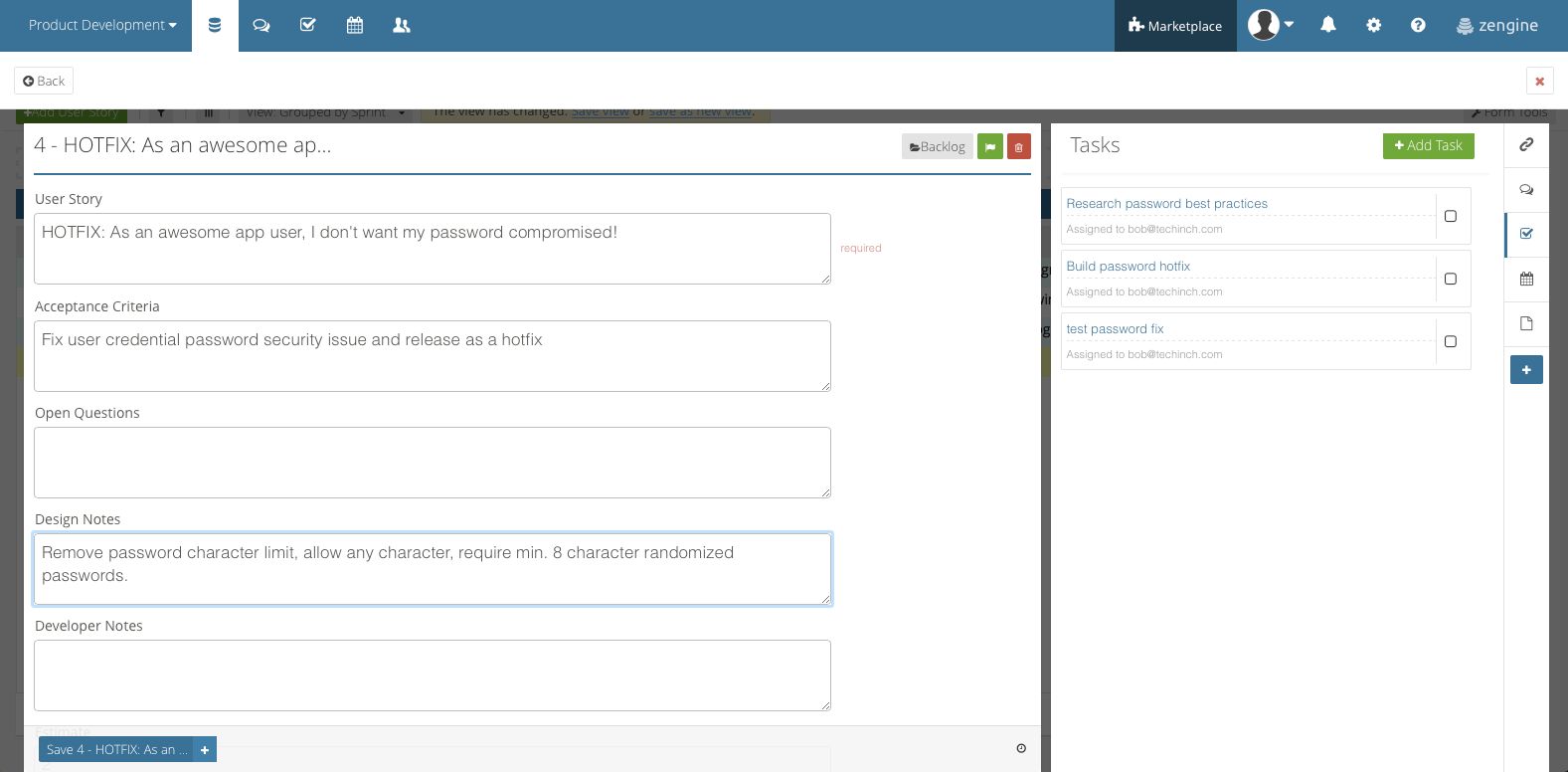
The first thing you'll think about with a new app is the data it needs to collect—something you'd likely gather in a form. Zengine starts right at the basic, having you build forms for your app that it then turns into a database. It's as simple to use as a form builder app, with a drag-and-drop interface to add text, number, date and other fields to your forms, each with advanced options if you want to, say, limit a text field or validate data.
You'll never haver to worry about how the database itself works, as Zengine will create it for you automatically based on your form fields. Then, each form entry will include tasks and events, which you can then view together from all of your apps on the Zengine dashboard for a simple way to make sure you never forget anything urgent, no matter how many apps you add to your account.
- Price: From $79/month for core plugins, 20k records, and 5 users
- Skill Level: Beginner—easy to use, with advanced features for power users.
For a deeper look at features and pricing, see our Zengine review .
Podio
for building an ecosystem of apps
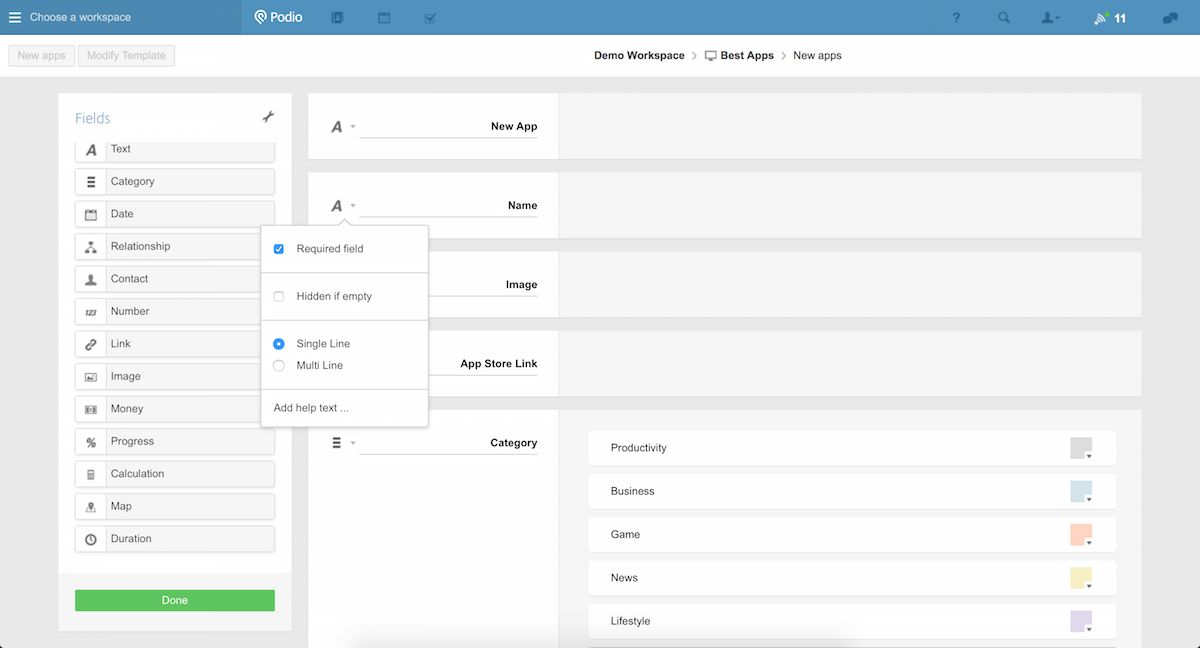
Want a way to keep all of your team's work together, and also make your own apps? Podio might be the best option for you. It's a business social network, with a live activity stream of what everyone's working on, individual and team chat, and workspaces to keep everything organized. And, it also includes hundreds of pre-made apps to manage everything—project, accounting, marketing, news, files, and so much more—along with a simple app builder to make anything you want.
You can install a tool from the Podio App Market and tweak it for your needs, or make your own internal tool by dragging in simple form fields. Then, your team can add data from the form, organize it in tables, boards, lists and more, have data automatically added to apps via RSS, email, Podio Extensions or from other apps via Zapier. It's incredibly simple to start using, and will make nice looking simple internal tools—though perhaps without as advanced of features as you could script together with more database-centric tools.
- Price: Free for up to 5 users; from $9/user/month Basic plan with most features
- Skill Level: Beginner—simple to use, but needs to be used with other Podio apps to get most benefit
For a deeper look at features and pricing, see our Podio review .
Transpose
for creating custom workflows for your business
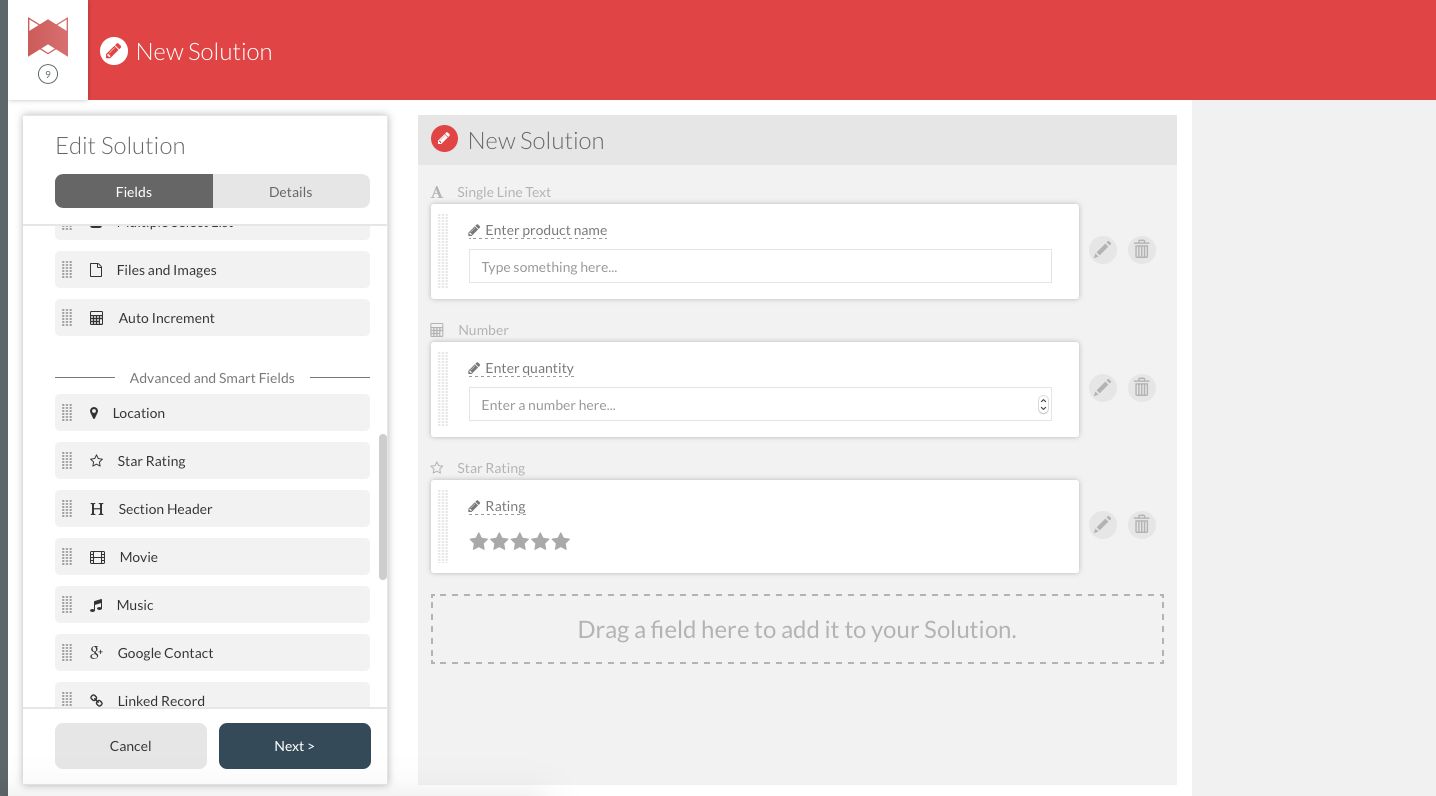
For custom apps that work even when you're offline, Transpose is an app builder that pulls in features from mobile data collection apps. You'll build apps in your browser with form fields, linking fields to create a relational database and pulling in documents, images, and locations for a full-featured experience. Then, you can visualize your items in table, calendar, card, or kanban views, or download individual records in PDF format.
Then, when you're on the go, you can use your Transpose app from your mobile device, adding new data and viewing entries even when you're offline. And to keep your team working together, you can assign database entries to anyone on your team so nothing gets forgotten.
- Price: From $9.99/month for unlimited apps with core features
- Skill Level: Beginner—easy to get started with pre-made solutions or form builder
For a deeper look at features and pricing, see our Transpose review .
Airtable
for spreadsheet-style database management

Databases don't have to be so complicated. Airtable is a new online database tool that feels much like using any standard spreadsheet app—albeit a spreadsheet with far more features. You can just list data in rows and columns, and quickly calculate sums. Then, you can add photos, filter your data, and more. And for even more power, you can reference data from other tables, letting you link entries and build powerful databases without ever getting outside your spreadsheet comfort zone.
Everything's graphical and easy to understand, and you'll never have to worry about how to do anything. Even making a form to let others enter data into your app is simple, as Airtable will automatically generate forms with appropriate fields for each of the columns in your table that you can customize as you want. You can even take your data on the go with Airtable's mobile apps, so you can pull up records or gather data when you're away from the office.
- Price: Free for unlimited databases with up to 1,200 records per database; from $12/user/month Plus plan for 5k records per database and granular access controls
- Skill Level: Beginner—easy to use if you're used to using a spreadsheet
Zoho Creator
for building advanced apps with scripting
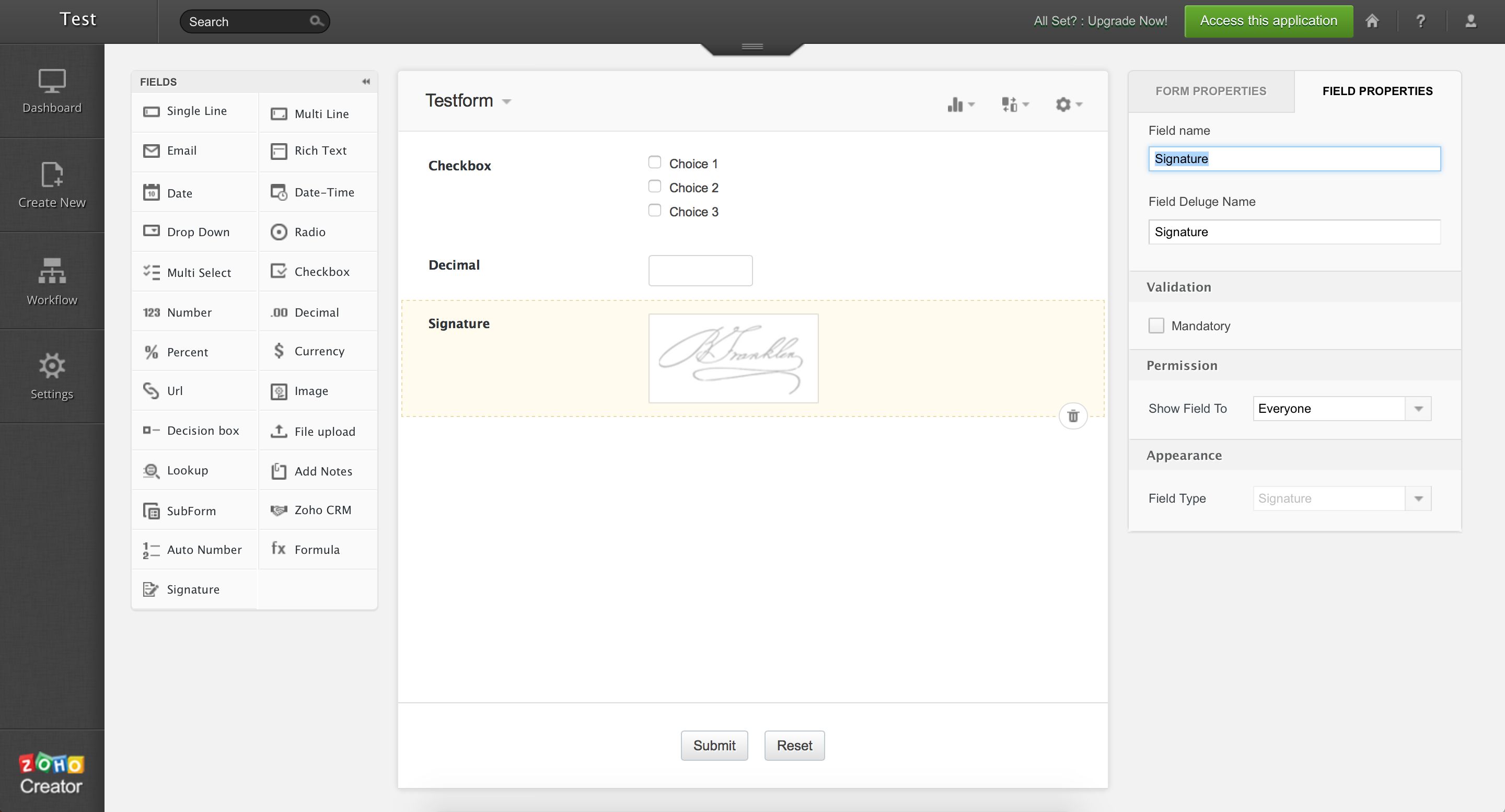
You're reading through this list of database builders so you can build your own tools without coding—but Zoho Creator might convince you that a little coding isn't so bad. It's a form-and-database-focused app builder just like the others, but it also includes simple workflows that'll help beginners write code.
Start off by adding form elements to your Zoho Creator app, and it'll make the appropriate database tables from those fields. Then, you can add custom actions to each field to verify data, show or hide fields based on what's entered, and display data from your database. Each of these actions can be hand-coded, or you can click buttons to add the code directly and then tweak it yourself. Then, when you're done with your database, you can code your own pages to display the data in the same way.
Zoho Creator can still be a simple app for building internal tools—you could just make forms and use its pre-made views to quickly put together your own tool—but it can also let you make much more advanced tools if you want to dig a little deeper.
- Price: Free for 3 apps and 750 records; from $5/user/month beyond that
- Skill Level: Intermediate—easy to get started using, but scripting will take more effort
For a deeper look at features and pricing, see our Zoho Creator review .
QuickBase
for building advanced apps with scripting
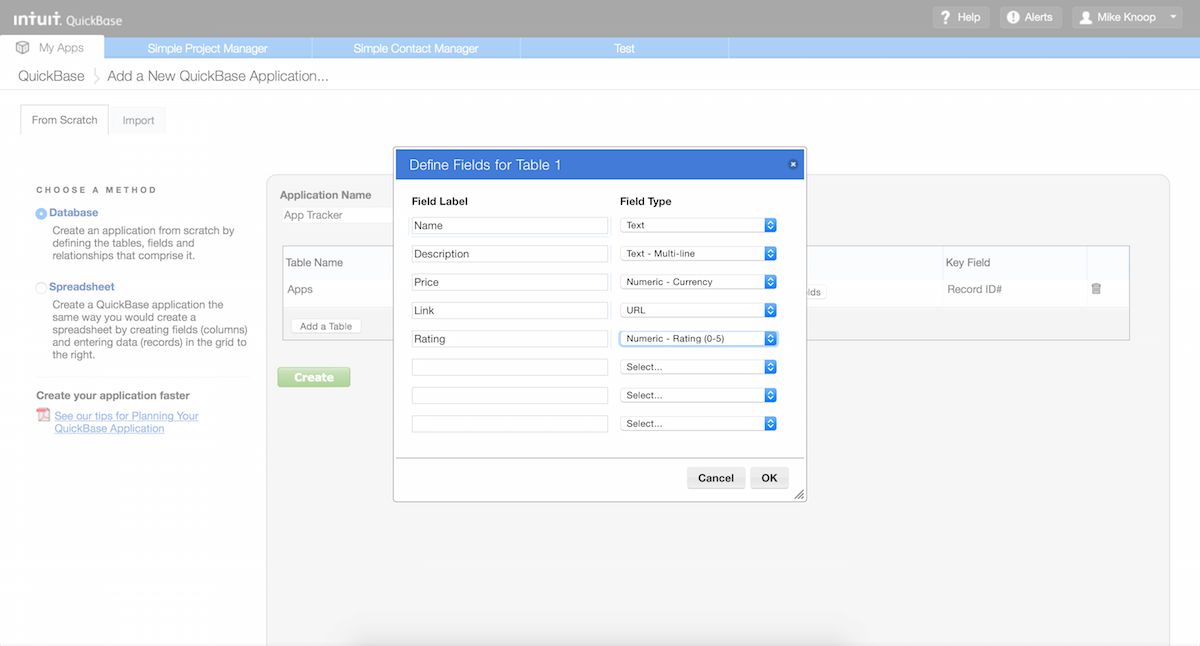
From the same team as QuickBooks, Intuit's QuickBase is another great way to build internal tools, either with a template from the QuickBase Exchange, a spreadsheet your team's already been using, or by hand-designing your database. You'll define every database field, then QuickBase will automatically make forms for adding new entries, and you can use QuickBase's quickly customizable dashboards and reports to analyze your data.
Then, if you're working in a team, QuickBase's best feature is its detailed permissions and workflows. You can set exactly what everyone on your team is allowed to see, add, and change, and then get QuickBase to do the heavy lifting with workflows that can automatically move and update data, and more. There's also extensions to add data from Google Maps, integrate document signatures and file uploads, and more.
- Price: From $15/user/month for basic app features
- Skill Level: Intermediate—there's more options to tweak, but you can make advanced workflows and set strict permissions
For a deeper look at features and pricing, see our QuickBase review .
Any Form App
for doing more with simple forms you already use
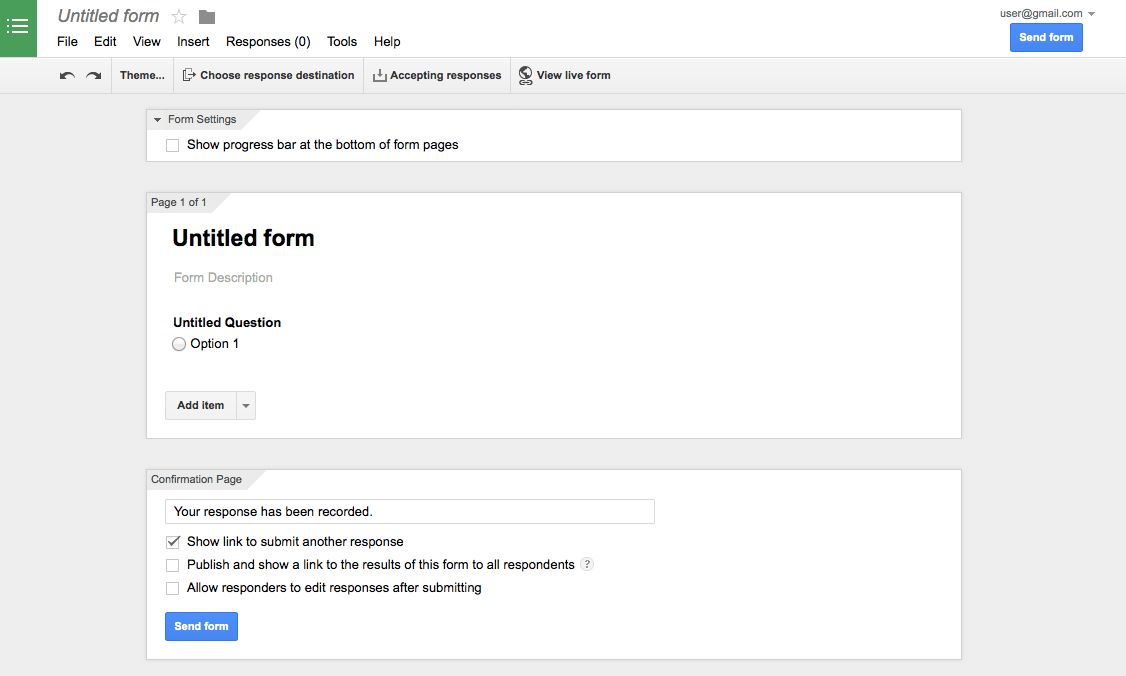
This chapter started off by telling you why a form isn't enough—and it really might not be on its own. But a form can be the first part of a series of apps that, together, can help you do a lot more.
You'll want to make your form first, adding fields for everything you need to collect, and possibly making more forms for other things you want to save. Then, you'll need to save your data to another app where it's easy to access—you could copy it to a Google Docs spreadsheet, or to Smartsheet where you can also update entries. You could even use Zapier to connect a form to a MySQL database, sending each new entry into the database. Alternately, if you use Google Sheets to make your form, your data will already be in a spreadsheet—and if you use iFormBuilder, you can push updated info back to your form's own database.
Then, you'll need a way to view and sort through your data—that's where the spreadsheet comes in. You can make new pages in your spreadsheet that let you visualize your data in charts and graphs, sort it with Pivot Tables, and use the simple filter and search tools to organize your data. And if you want to do anything else with your apps—send email notifications, publish blog posts, etc.—you can use Zapier along with your form or spreadsheet to trigger everything else you need done.
By the time you're done, you'll have built your own app with a form, and won't need to worry about setting up a "real" database. What really matters is that you're getting your work done in a tool that works for you and your team.
- Price: From free—and no additional cost if you're already using a form builder
- Skill Level: Intermediate—easy to make a form, but you'll have to work harder to make your data useful
Jump back to Chapter 2 for a roundup of the best online form builder apps to find a great app to make forms, then check Chapter 5's form automation guide for ways to make your form work more like a custom-built app.
WordPress + a Form Plugin
for self-hosted internal tools integrated with your blog
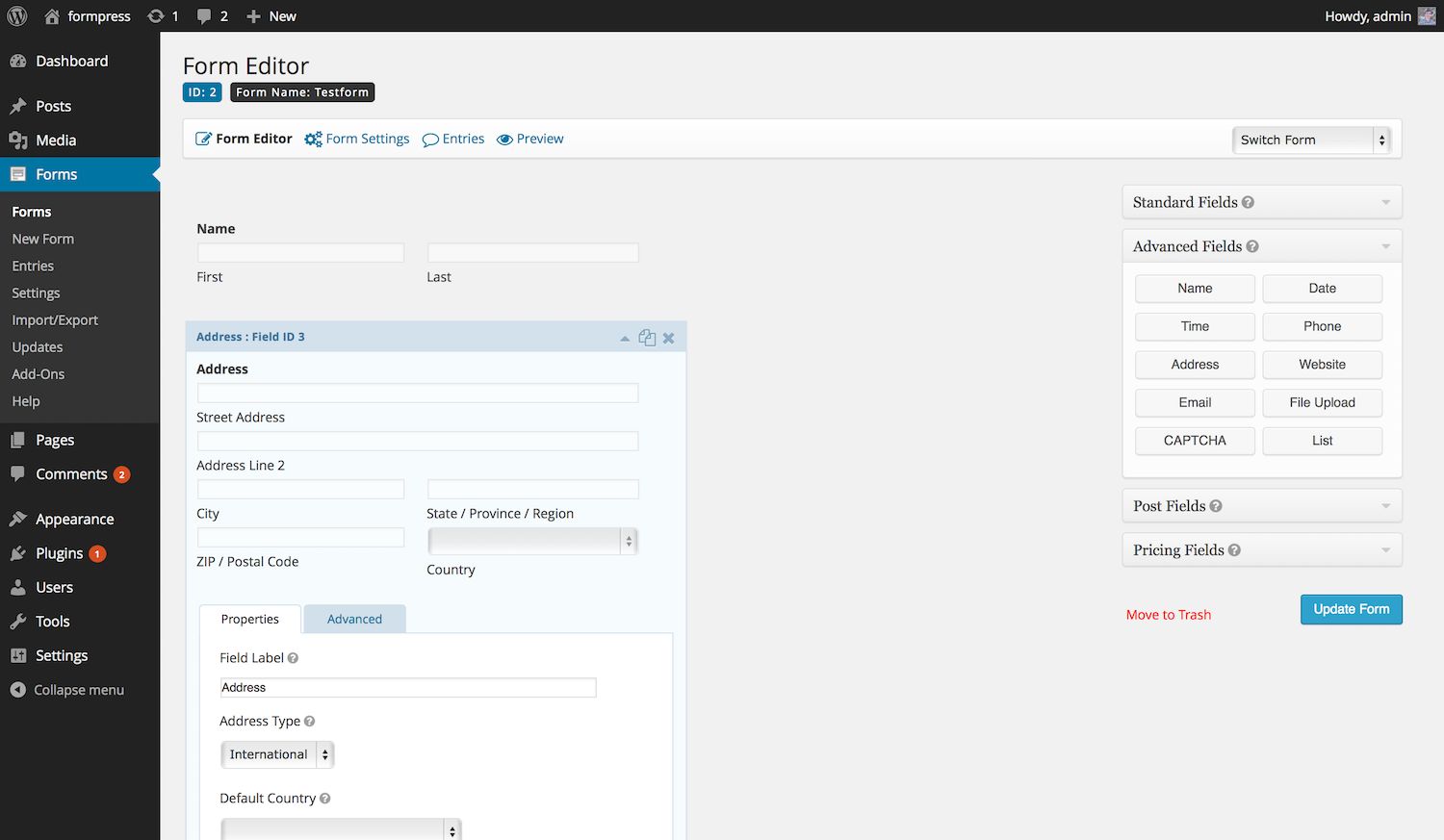
Yes, it's a blog engine. Yes, it's not your typical app builder. It's not even your typical form builder. But WordPress is built on a MySQL database, and if you're running it on your own servers, you can turn a WordPress installation into a feature-filled app that might not even include a blog.
You'll first need to install a WordPress form builder plugin—Gravity Forms, Formidable, and Ninja Forms are all great options. You'll build a form with your form builder, and then whenever your form is filled out, your data will show up in your MySQL database. Now, you can use the form plugin's own features to display your form data in WordPress, or you can build your own MySQL queries or MySQL plugins to display your database info inside your own pages in WordPress.
It'll take a bit more work, but you'll end up with something almost as customizable as a hand-built MySQL app without the headaches of software development.
- Price: Free, plus form plugin and hosting costs
- Skill Level: Advanced—easy to make a basic form, but accessing the database will take more work
For a deeper look at features and pricing, see our WordPress review , then check our Gravity Forms review for info about a compatible form plugin.
Microsoft Access
for building tools on your PC with Office integration
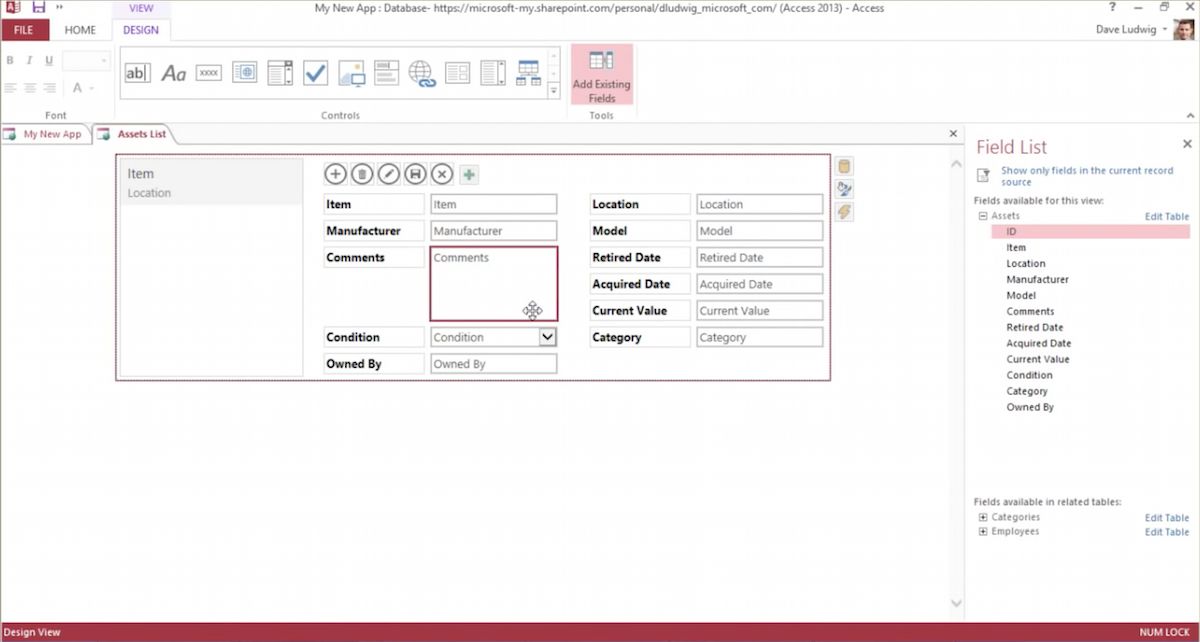
Microsoft Access was one of the original apps in the database-building space, and today it's still one of the easier tools out there. If you use a Windows PC for your work, and already have Microsoft Office, you can start making your own internal tools for no extra cost. They'll be tied to your computer, but that might work for a small business.
Or, you can use Access 2013 with Sharepoint or OneDrive Pro to build web apps in Access. You'll use the same set of tools to lay out your interface and database tables inside Access, and it'll turn them into an HTML5 and Javascript powered web app. You'll then publish it to Sharepoint, and let any of your team members add and view data online or in your intranet, just as with these other database builders. The main difference is that you'll need to use Access on a PC to build and edit your internal tool, and you won't be able to integrate with other apps as easily.
- Price: From $12/user/month for Office 365 Business Premium or ProPlus, including Office apps and online storage for Access web apps.
- Skill Level: Advanced—designing an app on your PC and uploading it to Sharepoint will take a bit more work than most of these other tools
If you want to build database-powered tools that only run on your computer and don't have a web app, LibreOffice Base is another database builder that's part of the LibreOffice (or OpenOffice) suite. It's free, and runs on Linux, OS X, and Windows, so that could be another great option for offline tools.
3. Put Your New Internal Tool to Work
"Although I have never written a line of code in my life I was able, with the video tutorials, to build a decent database and interfaces."
Once you've built a database-powered internal tool, you might be tempted to stop there. But don't: Your internal tool might be useful on its own, but it'll be far more useful if you integrate it with other apps to automatically import data, send notifications, and more.
Your database builder may include features to send notifications and perhaps will let you import data from a spreadsheet or other services. For everything else, you can connect your internal tool to Zapier and give it features from the hundreds of apps Zapier supports.
Here's some ideas from other teams who've built internal tools with these database builders:
Send Notifications
Your new internal tool may be able to send email notifications when new data is added, but after that it hits a brick wall. For everything else, you'll need Zapier.
Notifications about everything that happens in your internal tool might get tedious, but with filters in your Zapier integrations and workflow automations in your own app, you can get just the notifications you want. And, you can get them where you want—in your team chat app, via SMS or push notification, or even in a more customized email.
And, you can send notifications to your clients, contacts, and others that are important to your business from your internal tool if you want. The Web Gumption team, for instance, sends text messages to their clients with lead information directly from their Knack-powered tool.
Personalized features like that can surprise and delight your customers, as Web Gumption found out. "Our clients loved us because we opened up a whole new set of features for them," says Web Gumption's Rick Maggio.
Collect More Data
You can use the forms in your new internal tool to gather data as an easy way to add new customer contact info and more, but don't stop there. The best thing about your new internal tool is that you can update data in your database through Zapier, so you can use that to keep collecting more data automatically.
Marketer Adrien O'Leary uses this feature to create an entire workflow from his Knack database for managing clients. His clients will add email addresses to the Knack form, and a Zapier integration will then send a FluidSurveys invite to each of those contacts. Then, when they fill out the survey, it'll add the data back to Knack, along with other info from emails they've sent. Finally, it'll send an email via Mandrill when the project is complete.
You'll need to think through everything you're collecting in your internal tool when you're initially putting it together. Then, if you think about all the ways you can connect your new tool to other apps, you can make an even more powerful workflow that can do more than you'd ever imagined. "To me, using Knack together with Zapier feels like Access on steroids," O'Leary says.
Stay Connected
"Without it, we'd have to work with the more expensive and less-flexible lead distribution systems."
Building your own CRM (contact relationship management) tool is perhaps one of the best use-cases for these database builders, since the things each team needs to track about contacts, leads, prospects and more varies widely. Instead of worrying about customizing another tool, you can add fields for just the things you need to track, and make the workflow optimized for your team.
And then, you can optimize it for others, too. "Knack is the heart of our lead distribution system," Maggio says. "We use knack to capture lead information, store it, send it to clients and report to clients."
Internally, Knack is their team's full CRM. But then, thanks to Knack's flexibility when integrated with Zapier, they're able to add extra features for their customers. They send emails with lead information to customers with Mandrill, or used Zapier's SMS integration to send the lead info via SMS.
Most impressively, though, they've used Zapier to add leads to their clients' own CRM apps automatically from their Knack database. "They no longer had to add leads manually to their CRMs, Zapier did it for them!" says Maggio. That's enough to impress any client.
Whether you're using your new internal tool to collect customer data and send it to a CRM, or want to make an ingenious new workflow like the Web Gumption team did, Zapier's ready to connect to any apps you need.
Import Data
The new internal tool you've built might have forms, but you also may have other forms you're already using. There's no reason to pull them off your site now—just integrate them with your new tool, and they can become an essential part of your new workflow.
Fisher's team at Lotus Gardens uses Wufoo forms to let people create reservations, sign up for memberships, and more at their Tibetan Buddhist center. "We collect our program registrations and shuttle reservations through Wufoo and then transferred everything to Excel spreadsheets," Fisher says. "This created a nightmarish situation for staff—trying to manage, share and keep consistency in the sheets."
Once they discovered TrackVia and built a tool to manage all of their members, they integrated all of their Wufoo forms with their database, which simplified everyone's lives. Now, they can add each member's data when they sign up, then update the info when they create reservations for retreats. "The ease of getting our registrations/reservations through Zapier available for processing in TrackVia within in seconds keeps staff up to date and happy," Fisher says.
Your data might be elsewhere: you might be storing it in a Google Docs Spreadsheet, or it might be coming to your company in emails. Either way, you can connect them all to your new app with Zapier, to manage all of your data in one place.
Manage Finances
Finances are one of the most important—and annoying—things to manage. But with your own internal tool for finance that records every bit of financial info you need and can put that data to work automatically, you just might find that managing finances isn't so stressful.
That's what O'Leary did with Knack, using it to build another internal tool to track everything about his finances. Using Zapier, every new sale and its related data from PayPal is stored in Knack. Knack then calculates the fees from each transaction's currency, and send them to Freshbooks for his accountant's records. Then, once a week, Knack notifies his accountant about the new fees. It's a full finance system that's customized just for his needs.
InVigor Law Group added similar features for their own team's invoicing needs into their time tracking internal tool. Whenever a new customer is added to their TrackVia database, Zapier creates a new client in Freshbooks automatically. Once that client pays, Zapier sends the Freshbooks info back over to TrackVia.
Your own accounting needs may be different. You might need to send a receipt to customers, log sales to a spreadsheet that's shared with your accountant, or track canceled orders from your eCommerce system. Either way, you can connect your finance apps to your new internal tool and keep everything flowing smoothly.
Assign Tasks
When you're working in a busy team with a lot going on, you'll need a simple way to keep track of what everyone's working on. That's why the TrackVia development team made their own TrackVia-powered internal tool to manage tasks, to keep track of their projects and the tasks those projects entail.
The only problem was, the tasks started getting overwhelming. "When you are assigned a new task as a developer you get an email but that can flood your inbox pretty quickly," says TrackVia frontend developer Taylor Rose.
To solve that, he connected TrackVia to Slack, so he'd get a notification in Slack each time a task is assigned to him. "I receive desktop notifications on Slack whenever a new task is assigned to me," says Rose. "I can very quickly click into the task and assess the priority of it or start a discussion with the team about requirements." It keeps him connected to his team, without overloading his email inbox.
Depending on your team, you might use your internal tool itself to track tasks, or you might want to use your tool to create tasks in the to-do list app you're already using. Either way, a Zapier connection can keep things flowing and help you stay on top of what you have to do without overwhelming you with notifications.
Create Documents
Believe it or not, you can use your database-powered internal tool to create contracts, certificates, licenses, letters and any other form documents your team needs. You likely won't build a new word processor on your own, but you can use integrations with document template apps to create formatted documents from your tool.
That's how the Claim Bees team uses their auto insurance claims internal tool that they built with Knack. "I use my Zaps to take data from Knack and populate forms in WebMerge," says Claim Bees founder Matthew Whittall. "I automatically produce reports, invoices, charts, and more. The Zapier filter functions enable me to create some fairly complex routing rules, very easily."
Being able to simply create form documents is the main reason Whittall loves Knack. "I used to do the same job for my old employer—there our system didn't fit the requirement and the output was a barely structured e-mail," he says. "Now our work looks great for a fraction of the cost."
If you need to create your own form documents often, there's no need to open your word processor and copy data every time. Instead, just use the data you're already collecting in your new internal tool, and send it to WebMerge to fill in and create documents automatically.
Go Learn Something New!

Now that you know everything you need to build amazing forms and surveys, and use them effectively in your work, it's time to learn something else. The Zapier team has written an entire library of app guides and resources to help you get the most out of the apps you need in your work. Here are some of our most popular eBooks that you can start reading next for free:
- An Introduction to APIs
- The Ultimate Guide to CRM Apps
- The Ultimate Guide to Email Marketing
- The Ultimate Guide to Remote Work
Then, there's the Zapier blog, where you'll find articles like those included in the chapters of this book, along with articles about productivity, remote work, and more. Be sure to check out our blog and sign up for our email newsletters to be among the first to know whenever we publish new articles, free books and more.
Thanks for reading!
How To Design App To Collect Data Using Access
Source: https://zapier.com/learn/forms-surveys/simple-database-app-builders/
Posted by: schneiderfelist.blogspot.com

0 Response to "How To Design App To Collect Data Using Access"
Post a Comment